
The Seminole Wars were three related military conflicts in Florida between the United States Army and the Seminole, a Native American group which had coalesced in Spanish Florida during the early 1700s. The fighting occurred between about 1816 and 1858, with two periods of uneasy truce between active conflict. Both in human and monetary terms, the Seminole Wars were the longest and most expensive of the Indian Wars in United States history.

Osceola, named Billy Powell at birth in Alabama, became an influential leader of the Seminole people in Florida. Of mixed parentage, including Creek, Scottish, African American, and English, he was considered born to his mother's people in the Creek matrilineal kinship system. He was reared by her in the Creek tradition. When he was a child, they migrated to Florida with other Red Stick refugees after their group's defeat in 1814 in the Creek Wars. There they became part of what was known as the Seminole people.
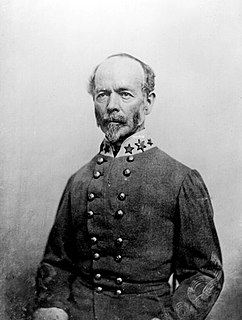
Joseph Eggleston Johnston was an American career army officer, serving with distinction in the United States Army during the Mexican–American War (1846–1848), and Seminole Wars. After Virginia seceded from the Union, he entered the Confederate States Army as one of its most senior general officers.

The Second Seminole War, also known as the Florida War, was a conflict from 1835 to 1842 in Florida between various groups of Native Americans collectively known as Seminoles and the United States, part of a series of conflicts called the Seminole Wars. The Second Seminole War, often referred to as the Seminole War, is regarded as "the longest and most costly of the Indian conflicts of the United States."
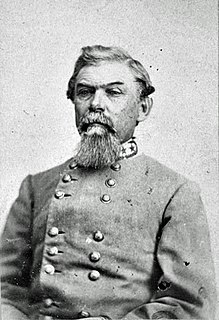
William Joseph Hardee was a career U.S. Army and Confederate States Army officer. For the U.S. Army, he served in the Second Seminole War and in the Mexican–American War, where he was captured and exchanged. In the American Civil War, he sided with the South and became a general. Hardee served in the Western Theater and quarreled sharply with two of his commanding officers, Braxton Bragg and John Bell Hood. He served in the Atlanta Campaign of 1864 and the Carolinas Campaign of 1865, where he surrendered with General Joseph E. Johnston to William Tecumseh Sherman in April. Hardee's writings about military tactics were widely used on both sides in the conflict.
The Battle of Lake Okeechobee was one of the major battles of the Second Seminole War. It was fought between 800 troops of the 1st, 4th, and 6th Infantry Regiments and 132 Missouri Volunteers, and between 380 and 480 Seminoles led by Billy Bowlegs, Abiaca, and Alligator on 25 December 1837. The Seminole warriors were resisting forced relocation to a reservation in Oklahoma. Though both the Seminoles and Taylor's troops emerged from the battle claiming victory, Taylor was promoted to the rank of Brigadier General as a result, and his nickname of "Old Rough and Ready" came mostly due to this battle.
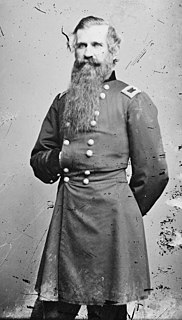
John Cleveland Robinson had a long and distinguished career in the United States Army, fighting in numerous wars and culminating his career as a Union Army brigadier general of volunteers and brevet major general of volunteers in the American Civil War. In 1866, President Andrew Johnson nominated and the U.S. Senate confirmed Robinson's appointment to the brevet grade of major general in the regular army. He was a recipient of the Medal of Honor for valor in action in 1864 near Spotsylvania Courthouse, Virginia, where he lost a leg. When he retired from the U.S. Army on May 6, 1869, he was placed on the retired list as a full rank major general, USA. After his army service, he was Lieutenant Governor of New York from 1873 to 1874 and served two terms as the president of the Grand Army of the Republic.

Elon John Farnsworth was a Union Army captain in the American Civil War. He commanded Brigade 1, Division 3 of the Cavalry Corps from June 28, 1863 to July 3, 1863, when he was mortally wounded and died at the Battle of Gettysburg. He was nominated by President Abraham Lincoln for appointment to the grade of brigadier general on June 29, 1863 but was not confirmed by the United States Senate before his death at Gettysburg.
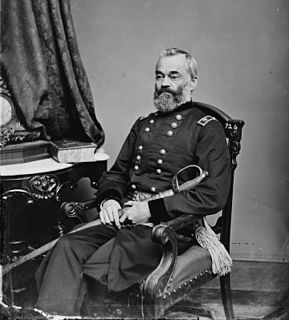
Samuel Peter Heintzelman was a United States Army general. He served in the Seminole War, the Mexican–American War, the Yuma War and the Cortina Troubles. During the American Civil War he was a prominent figure in the early months of the war rising to the command of a corps.

John Garland was a career United States soldier in the Regular Army who had a long and distinguished career spanning fifty years of service during the War of 1812, Seminole Wars, Mexican–American War, Utah War and very briefly into the American Civil War.

The Jupiter Inlet Light is located in Jupiter, Florida, on the north side of the Jupiter Inlet. The site for the lighthouse was chosen in 1853. It is located between Cape Canaveral Light and Hillsboro Inlet Light. The lighthouse was designed by then Lieutenant George G. Meade of the Bureau of Topographical Engineers. Meade's design was subsequently modified by Lieutenant William Raynolds. The Jupiter Inlet silted shut in 1854, forcing all building supplies to be shipped in light boats down the Indian River. Work was interrupted from 1856 to 1858 by the Third Seminole War. The lighthouse was completed under the supervision of Captain Edward A. Yorke in 1860 at a cost of more than $60,000.

Thomas Sidney Jesup was a United States Army officer known as the "Father of the Modern Quartermaster Corps". His 52-year (1808–1860) military career was one of the longest in the history of the United States Army.

The State of Muskogee was a proclaimed sovereign nation located in Florida, founded in 1799 and led by William Augustus Bowles, a Loyalist veteran of the American Revolutionary War who lived among the Muscogee, and envisioned uniting the American Indians of the Southeast into a single nation that could resist the expansion of the United States. Bowles enjoyed the support of the Miccosukee (Seminole) and several bands of Muscogee, and envisioned his state as eventually growing to encompass the Cherokee, Upper and Lower Creeks, Choctaw and Chickasaw.
Ar-pi-uck-i, also known as Abiaka or Sam Jones, was a powerful spiritual alektca and war chief of the Miccosukee, a Seminole–Muscogee Creek tribe of the Southeast United States. Ar-pi-uck-i successfully defied the U.S. government and refused to remove to the Indian Territory west of the Mississippi and his influential leadership in the Second Seminole War (1835–1842) resulted in the permanent Native American presence in Florida.
James Lowry Donaldson was an American soldier and author. He served as a general in the Union Army during the American Civil War and was noted for his proficiency in military logistics.
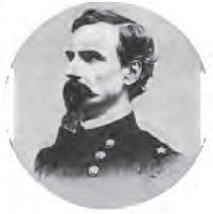
John Wynn Davidson was a brigadier general in the United States Army during the American Civil War and an American Indian fighter. In 1866, he received brevet grade appointments as a major general of volunteers and in the regular U.S. Army for his Civil War service,

William Wing Loring was an American soldier who served in the armies of the United States, the Confederacy, and Egypt.

James McQueen McIntosh was a career American soldier who served as a brigadier general in the Confederate Army during the Civil War. Noted as an aggressive and popular leader of cavalry, he was killed in action at the Battle of Pea Ridge.
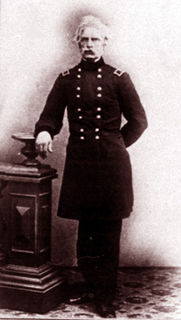
Harvey Brown was an American military officer who fought in the Black Hawk and Seminole Wars, the Mexican–American War and the American Civil War. He was also in command of military forces in New York City and later assisted in putting down the New York Draft Riots in 1863. His son Harvey E. Brown, Jr. also had a prominent military career as a surgeon and later historian of the U.S. Army Medical Department.
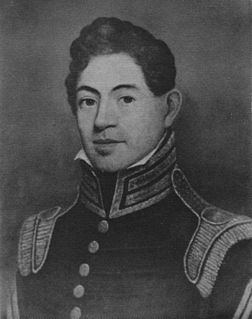
Benjamin Kendrick Pierce was a career officer in the United States Army. He was a son of New Hampshire Governor Benjamin Pierce and brother of President Franklin Pierce. Benjamin K. Pierce was a veteran of the War of 1812, the Second Seminole War, and the Mexican–American War, and rose to the rank of Lieutenant Colonel in the Army and Colonel in the Florida Militia.
















